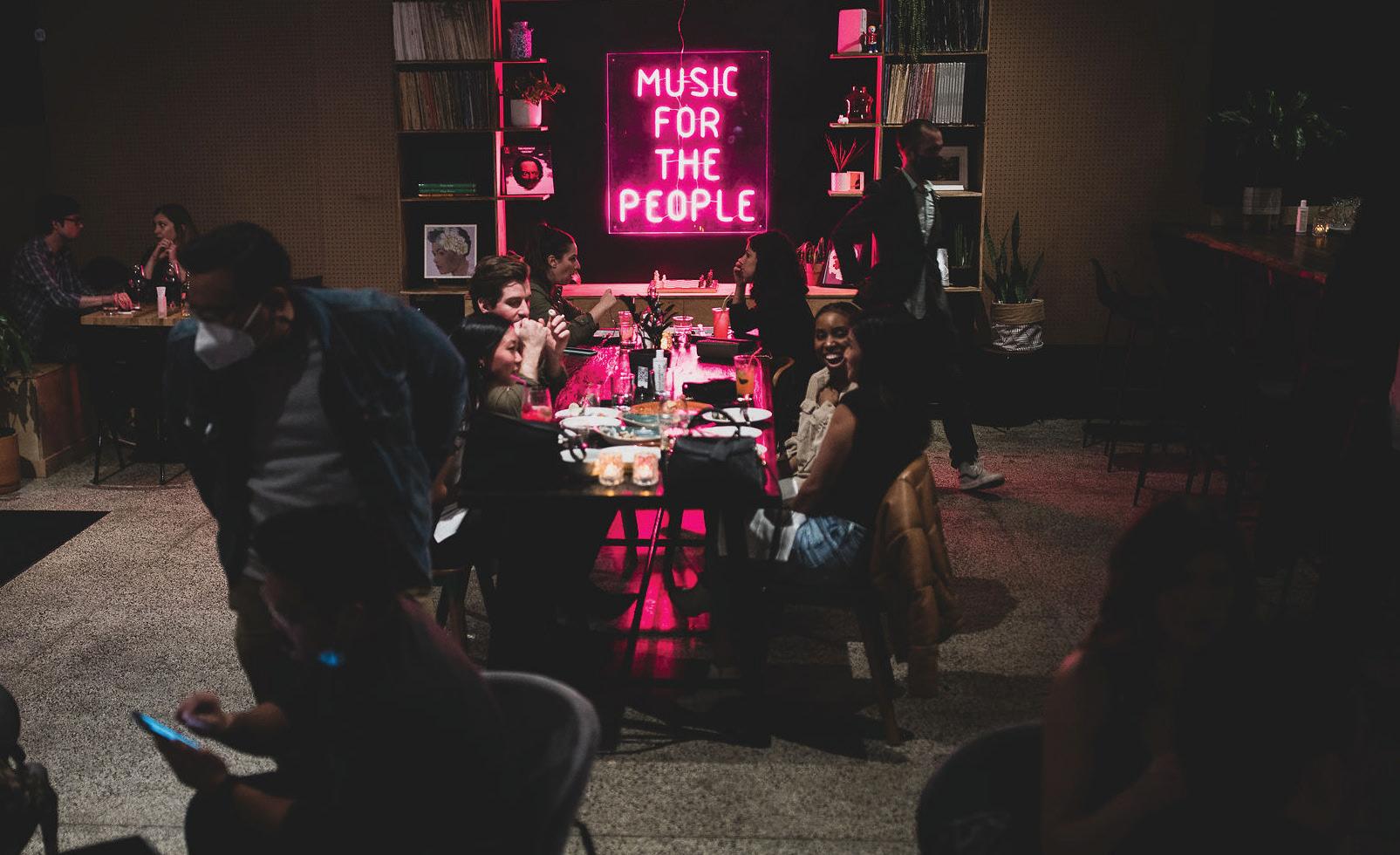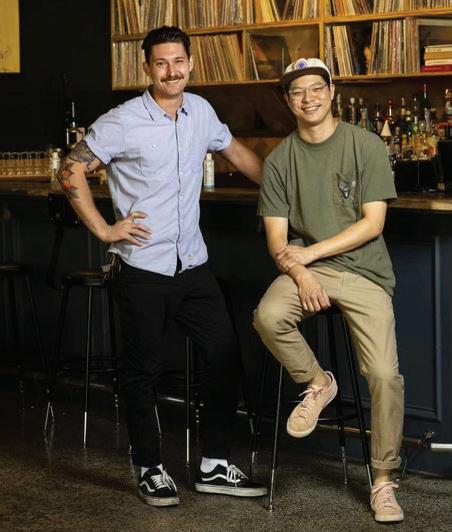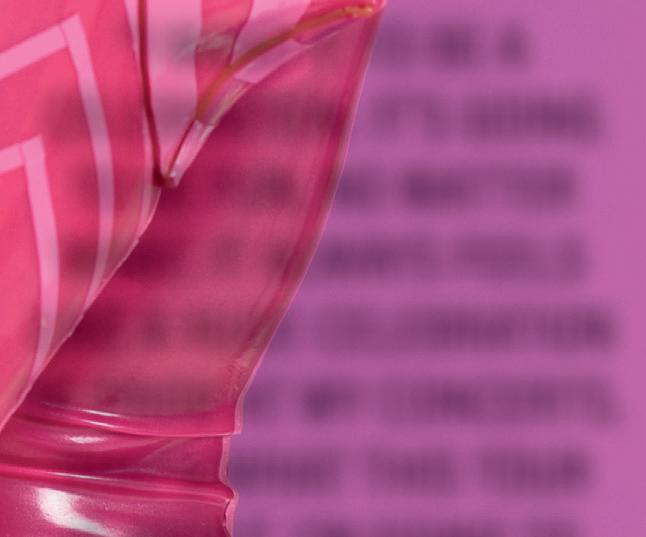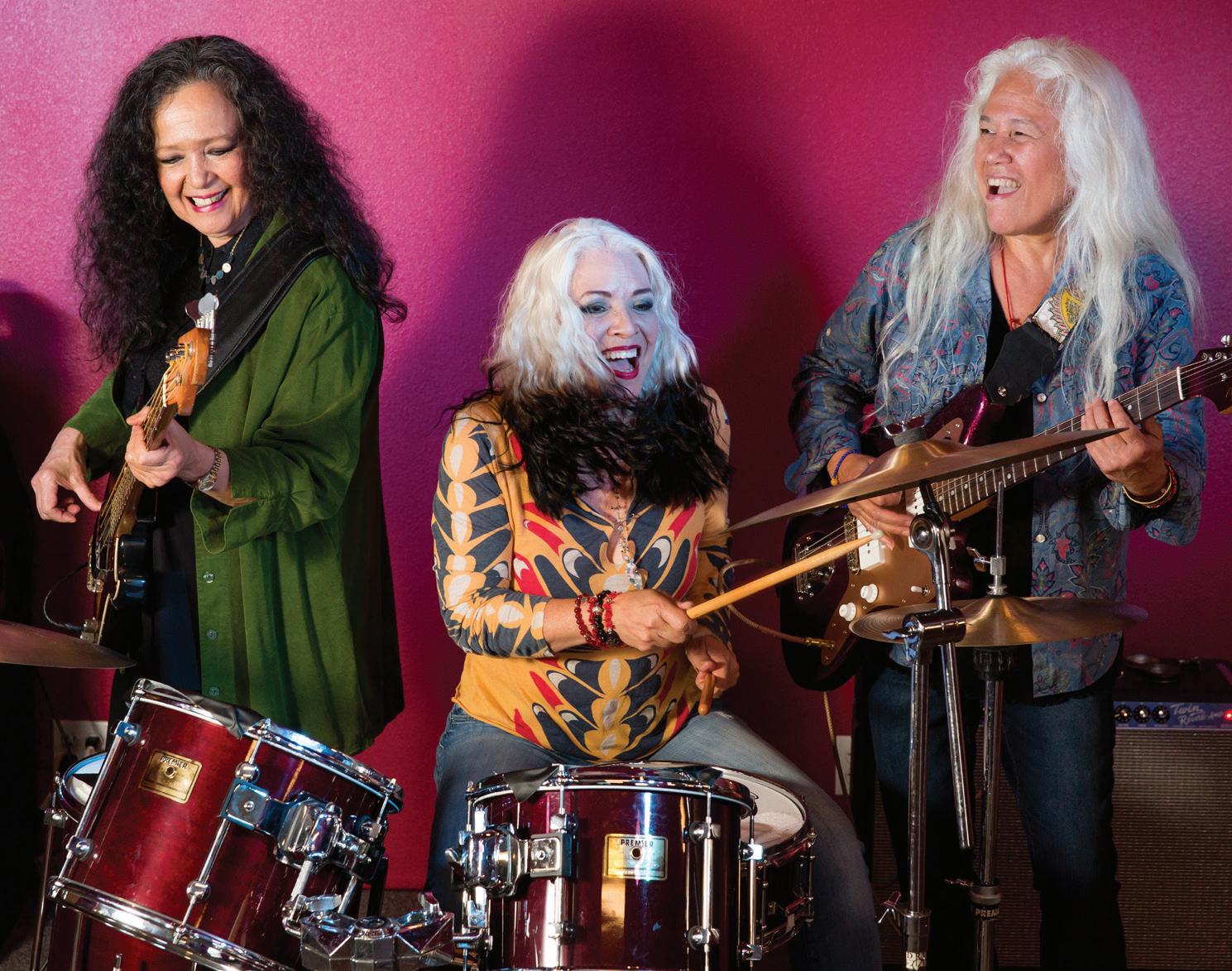
15 minute read
DINING OUT
from MARCH 2022
Eat, Drink, Listen
93 Til brings Tokyo’s record-bar culture to Montrose.
By MARENE GUSTIN Photos by ANNIE MULLIGAN
The chorus of “93 ’til Infinity,” the breakout hit from that debut album released in 1993 by the West Coast hip hop artists Souls of Mischief, inspired the creation of the 93 Til record bar and lounge in Houston. Founded by California chefs Gary Ly and Lung Ly (no relation), the restaurant and bar occupies the former Montrose home of Night Heron.
“My family and I moved from California to Conroe in 1993,” says Lung. “So the song has a special meaning to me, and it just seemed to fit the vibe I wanted here.”
Opened in late 2020, Lung had a rough time dealing with the pandemic and waiting for the liquor license. He says they just gave away free alcohol, beer, and wine. “But that wasn’t sustainable!” he laughs. 93 Til is the epitome of Tokyo’s recordbar culture, with its Mid Century design and furniture from Austin’s BRWN Collective. The Audio-Technica turntable spits out hip hop, jazz, rap, and funk tunes, among other styles. (The playlist is printed on the menu.) The bar sends out carefully curated craft cocktails and spirits, and the kitchen (now helmed by Lung and chef Jeff Potts, who took over from Gary) creates instant classics such as foie gras, PB&J, and a classic chicken sandwich that may be one of the best fowl sammies in town. It’s topped with slaw, house pickles, and honey mustard on a brioche bun.
“I think the main reason to come is the music and the neighborhood vibe,” Lung says. “But we also have really good food and drinks.”
The dinner and weekend brunch menus are mostly locally sourced, and items change throughout the seasons. But right now, Ly is really liking the beef carpaccio, an Italian-style roast beef rub, horseradish crème fraîche with marinated beech mushrooms and chive oil, and a parmesan crisp.
“We also have a redfish dish from Turtle Creek Aquaculture,” he says. Turtle Creek runs a sustainable fishery in Palacios, Texas, near Matagorda Bay. “It’s so fresh, I think they grab it right out of the pond and bring it to us.”
With a small kitchen space, Lung now leaves most of the cooking to chef Potts and spends most of his time on the management side. 93 Til’s other team member is bar manager Tim Vaughn, who makes a mean version of an Old Fashioned in a smoked glass. “He likes to be creative, and I love watching him play around with drinks,” Lung says.
Tuesdays through Fridays from 4:00 to 6:00 p.m., you can enjoy Happy Hours with bar-special bites like flavored popcorns, wings, and deviled eggs, all under $10. Cocktail specials are $8, and beers are $4. Brunch, which is served Saturdays and Sundays from 11:00 a.m. to 3:00 p.m., features a spicy chicken pozolé, a huge hangover burrito, churro French toast and, of course, the traditional biscuit and gravy with eggs your way.
But food and drink aside, 93 Til is a great place to just, as the song says, chill. “Honestly, I just think 93 Til is a cool place to hang out,” says Lung. “When we started off it was a lot of the young dating crowd, but now it’s all walks of people, and we have real neighborhood regulars.”

93 Til chef Jeff Potts (l) and owner Lung Ly
Powerhouse Performer
Todrick Hall brings his new tour to House of Blues this month.
By GREGG SHAPIRO Photo by POL KURUCZ
Is there anything Todrick Hall can’t do? The gay Texas native sings and dances. He writes songs. He acts on Broadway, in movies, and on TV. He’s also an outspoken activist. On Hall’s blockbuster new album Femuline, he is joined by all-star collaborators including Chaka Khan, Brandy, Tyra Banks, and Ts Madison, and the queer energy and spirit is through the roof. In fact, Hall tears off the roof and turns it into a fabulous costume. Hall was kind enough to take a few minutes to talk with OutSmart about his new album as well as his upcoming concert tour, which stops at Houston’s House of Blues on March 27.
Gregg Shapiro: Todrick, in “The Foreplay,” Femuline’s album opener, you describe it as a “Gay National Anthem” (which I think actually applies to the entire album) and an “open love letter to the LGBTQ community.” As an LGBTQ ambassador, what do you think of the rapid strides the community has made in recent years?
Todrick Hall: It makes me feel optimistic about where the world is going. I feel like we’re nowhere near where we need to be. As a queer person today, I don’t think I can list a single song where a man is singing to another man using a pronoun that would typically be used to describe a man. We have all the technology in the world, and we can fly people to outer space and do insane things with science and technology, but the fact that we have not yet advanced to the place where men can sing to other men on the radio without it being kind of sugar-coated and not addressed head-on is a sad thing. I’m grateful for the strides that we’ve made, but we’re nowhere near where we need to be in normalizing being a part of the LGBTQ+ community. That is my goal with every project that I do: to introduce my music and my message not just to people who are from my community, but to the allies and people who are heterosexual fans and followers that happened to tumble across my videos on YouTube.
The divas came out to play with you on Femuline, beginning with the goddess Chaka Khan who can be heard on the song “Fabulosity.” Please tell the readers how your collaboration with Chaka came to be.
Chaka Khan and I did The Color Purple on Broadway in 2007 or 2008. She didn’t actually remember that I was in the ensemble because she was only in it briefly. But I’ve always had such a huge love for her, and was able to watch her from the wings [during those Broadway shows] and hear her in a way that most people wouldn’t be able to. When you hear someone sing eight shows a week on a Broadway stage, you [gain] a huge amount of respect for their instrument and their gift. When she walked into the room to sing “Fabulosity,” she needed no warmups. She just said, “Press record and let’s go.” [Laughs] It was incredible to watch. It was like one of those moments in my life where I was like, “This is iconic!” To be able to soak up her energy and listen to her stories about working with [so many iconic] people. To talk to someone who knew Prince or Luther Vandross, or was friends with Whitney Houston, was a remarkable thing that a lot of people don’t get to experience. That was eye-opening and life-changing for me—one of those bucketlist things, and a milestone in my career that I’ll never forget.
Talk about fabulosity! Brandy is another grand diva with whom you teamed up on the song “Click Clack.” What was it like working with her?
Brandy and I have been friends for a while. It’s really cool to work with Chaka Khan, but to be in the presence of Brandy is otherworldly to me. She was the first Black princess that I saw [in the 1997 television movie Cinderella], and it was one of the first times I realized how beautiful a Black woman could be. I had seen many beautiful Black women around me growing up, but to watch everyone become obsessed with how gorgeous she was in that movie—I didn’t realize how impactful that would be for me! Not just at that moment, being a kid in fifth or sixth grade, but throughout my entire life. To get to work with her is game-changing. That movie is what planted the seed in me that made me want to be a Broadway performer and pursue dancing and singing. In a lot of ways, Brandy has been an icon to me my whole life. She’s now a mentor to me, and in some weird way she is my fairy godmother—the way Whitney Houston was her fairy godmother in that movie, and in real life. In so many chapters in my life, I’ve gone through things that celebrities or public figures go through. And you can’t really get advice from your close personal friends, because [they can’t] imagine the heartaches and back-stabbings that I’ve gone through [professionally]. If you look through Brandy’s career, she has gone through such tragic things so many times, and she’s come through victorious and still her voice shines. She’s been able to give me some lifelong advice that has helped me. She’s not just somebody that I collaborate with, she’s somebody I consider to be a very good, close friend.
That’s beautiful! None other than Tyra Banks joins you on the song “Fashion.” Please say something about the role that fashion and style plays in your life.
It’s everything to me. When I grew up, I used to try to fit into the status quo and wear the things that young Black boys were supposed to wear in Texas at that time. It took me a while. I’ve made some questionable fashion choices. My mom called me at one point and asked, “Why do you have to wear waffles and ice cream on your head?” I think it was a form of expression for me to scream out and stick out from the crowd. Wearing T-shirts and jeans wasn’t something that ever spoke to me—no offense to all the people who follow the Simon Cowell look. I always wanted to wear things that were one-of-a-kind and you wouldn’t even know where to get it. I love when I see Beyoncé wearing something and I’m like, “Where would they even make that?” Or Lady Gaga wearing clothes that look like they’re art pieces. Or boundary-pushing drag queens like Aquaria— from the way she does her makeup and her hair to the jewelry and clothes that she wears. It’s been incredible to be inspired by so many different things. Being a part of the drag community, the fashion even extends further than it does for the real fashion world. You can do anything, and no amount of campiness goes too far. Fashion plays a huge part in how I build my brand. I love when I can take something like a Solo cup and make a dress out of it—And make it such an iconic part of that era of music that my fans go home and do DIY projects, trying to figure out how they can construct a similar



—Todrick Hall
dress [laughs] out of Solo cups. It’s just so much fun, and it allows me to express myself in ways I’ve never been able to before. I love that it’s constantly evolving. I just live for fashion! I was so grateful that Tyra Banks found the time to squeeze me into what I’m sure was her crazy schedule.
The versatility inherent in the album’s title comes through loud and clear on the song “Both.” How important do you think it is to be versatile and flexible, both in life and in love?
I think that it was something that was so scary for me. Even if you’re a proud member of the LGBTQ+ community, there are so many rules within that community that [lead to people being] shunned and judged and put into boxes. Oftentimes, somebody who blurs with the feminine side, at least publicly, gets shunned and becomes less desirable to other gay men. That was a part of being in the community that I was super-insecure about. In my relationships, I never wanted the guys that I was dating to see me having heels or wigs around. I know a couple of guys who told me that when people come over for dates they hide their heels. It was such a sad part of our community. I think writing an anthem that made people feel comfortable and confident about that aspect of being gay was something that was really important. I wrote that song, and it is actually my favorite song. I think it’s such a powerful song. As far as I know, there are no other songs that tackle that topic. I’m grateful that people have gravitated toward that song in the way they have.
The song “Dick This Big” features Ts Madison, and the aptly named “Berserk” uses the terms of endearment “sis” and “bitch,” which were also utilized to great effect in a scene in the movie Zola, in which Ts Madison appears. Have you seen the movie, and what did you think of her performance?
I have not seen that movie, but I have experienced Ts Madison on so many levels, so I can only imagine how incredible she would be in that movie. She is a superstar and has been doing so many things to break down barriers and boundaries—things that, at the time, could have seemed like a grotesque statement. But now look at the things that she’s done. She’s always been trailblazing and standing up for people who are in that category that people didn’t understand. She’s somebody who’s been unapologetically herself for so long. She’s given so many people the confidence to walk in her footsteps. I just think she’s incredible. She’s such a badass. That term gets thrown and stamped onto people who I don’t feel possess that badass energy. But Ts Madison is the definition of what it means to be badass after living her truth, even if everybody doesn’t understand
Women Who Rock
MFAH screens a new documentary about a historic queer-led, all-female rock band.
By DON MAINES
The four gutsy women—including two lesbians—in a 1970s all-girl band are called “the first ladies of rock & roll” in the new documentary Fanny: The Right to Rock, which screens March 18 and 19 at the Museum of Fine Arts, Houston.
“Fanny was the first all-woman rock band that could really play and really get some kind of recognition in the music community,” says Bonnie Raitt, a Rock & Roll Hall of Famer who is one of many music legends who sing Fanny’s praises in the film.
In a December 1999 issue of Rolling Stone magazine, the late David Bowie wrote, “One of the most important female bands in American rock has been buried without a trace. And that is Fanny. Revivify Fanny. And I will feel that my work is done.”
“They had balls,” adds Gail Ann Dorsey, a bassist who played in Bowie’s band.
Director and co-producer Bobbi Jo Hart heeded Bowie’s call several years ago, about the same time that Fanny’s out lead guitarist, June Millington, was being honored for founding the Institute for the Musical Arts, a groundbreaking underground music camp and recording studio for girls and women in the woods near Goshen, Massachusetts.
Millington told OutSmart that Hart’s camera crew also “happened upon” Millington’s reunion with fellow Filipina American bandmates (her bass-playing sister, Jean, and Fanny’s original drummer, Brie Darling) to record a new album for the group’s 50-year anniversary.
Out drummer Alice de Buhr, who joined Fanny after Brie got pregnant, also spoke to OutSmart. She reveals in the documentary that becoming the first all-girl band to release a major-label album (Warner/ Reprise, 1970) thrust the group into the headwinds of sexism and homophobia.
“Being gay was still a disease back then,” she recalls, “so you could not be [out as a lesbian] in the band. We had to have boyfriends or significant others. The record company did not know what to do with us.”
Alice was the first to leave the band, followed by June. Fanny continued by using replacement members dressed in skimpy costumes. However, by the time Fanny released its biggest hit, “Butter Boy,” the group had disbanded.
“I think Fanny was 10 years too early,” says Alice, who manages the website fannyrocks.com, which is dedicated to preserving Fanny’s history.
Nevertheless, it was a wild ride for a group that almost became the female Beatles. Other high-fives in the film come from Kate Pierson of the B-52s, Cherie Currie of The Runaways, and Kathy Valentine of The Go-Go’s. Among the men who confess their love for Fanny are Todd Rundgren, Charles Neville of The Neville Brothers, John Sebastian of The Lovin’ Spoonful, and Def Leppard’s Joe Elliott.
Hart’s film reveals the band’s origin story as a backyard band of teenagers in 1960s Sacramento. In its heyday, the group rented Fanny Hill, a Hollywood Hills home that hosted jam sessions with the likes of Joe Cocker, Little Feat, and Bob Dylan’s The Band.
Alice told OutSmart that her road to rocking and rolling began as a second-grader in a school band in Iowa. In her junior year of high school, she graduated to a small drum kit. Then at 17, she fled for California.
June and her sister started by playing ukuleles, and June progressed to an acoustic guitar. When her sister’s boyfriend let her “jump on” his electric guitar, “It was empowering and liberating.”
What: Fanny: The Right to Rock screening at MFAH When: March 18 and 19 at 7:00 p.m. Where: Brown Auditorium, Museum of Fine Arts, Houston, 1001 Bissonnet Tickets: mfah.org
MADELONI PHOTOGRAPHY









